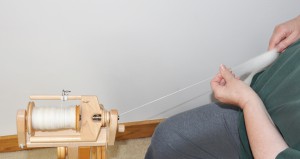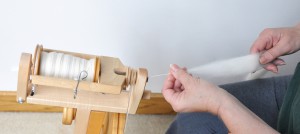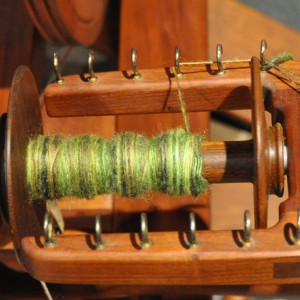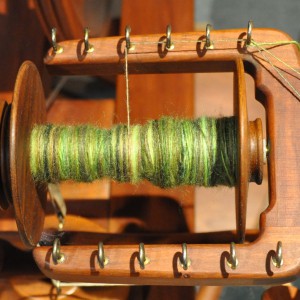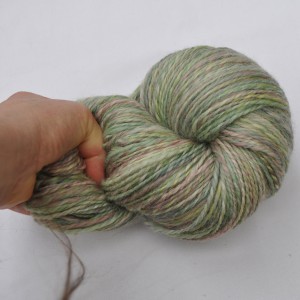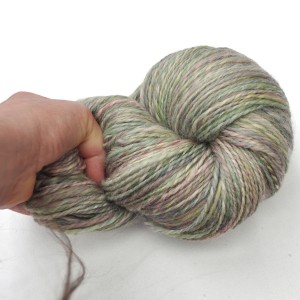Since Spinzilla is coming up, I thought I would talk about spinning for speed. (You might also want to read my other article about my “exercises” in spinning for speed and accuracy HERE.)
One of the forms of spinning that has become popular is the “inch-worm” or sometimes called the “worsted” method. The spinner holds the wool “package” (be it locks, rolag, roving, or tops) in the back hand (or hand furthest from the wheel), and uses the front hand to pull out the draft area and push the fiber towards the wheel. This can produce a very even and accurate yarn, especially for beginners, however, at a cost. The main cost is speed of spinning. There is a functional limit to how quickly you can perform this operation.
(NOTE: Though this is called “worsted method” it does not necessarily mean that the spinner is making worsted yarn. A worsted yarn is a yarn in which the fibers enter the spin parallel to the yarn. A woolen yarn is one in which the fibers enter the spin perpendicular to the yarn (from a rolag) or somewhat more randomly from carded roving. The “worsted” spinning method was used (and got its name) with very long stapled wool, when spinning from the lock. In that case, the fibers of the lock were fanned out and entered the spin from the tips (i.e. parallel). Now that people use this spinning method for many different fiber packages (rolags and carded roving) which do NOT produce a worsted yarn.)
An alternative spinning method is to have the back hand draw the wool. If the spinner tightens the brake so that the pull of the wheel is enough to draft the yarn (this also happens when there is a wide variance between the bobbin and drive whorls of a double banded wheel), then the hand holding the wool package is the one which is pulling out the draft area against the pull of the wheel. The other hand need not be involved at all as in the case of drawing from a rolag. This is called a “long-draw” which is essentially spinning with one hand. Or, if spinning combed tops or roving, or other more “slippery” fiber formats, then the front hand “holds back” the spin and slides (gently, no death grips here) along with the draw. In this case, both hands stay ABOUT the same distance apart during the draw and during the release into that strong pull of the wheel. Both hands move back and forth from the fully extended draw to the release onto the bobbin. This is called “woolen” spinning.
(NOTE: Again, the same thing holds true…the method does not necessarily produce a “woolen yarn” unless the fibers are perpendicular or random. Spinning a combed tops this way will NOT produce a woolen yarn, since the fibers are entering the yarn parallel to the length of the yarn.)
The back hand is pulling the wool away from the wheel and controlling the amount of wool that will be in the yarn. Your hand must be loose, so the wool in the roving, tops, rolag or whatever, can always be available to the draw area between your hands. Note that the spinning activity actually takes place some distance from the orifice of the wheel. This introduces another advantage: you can pull out VM, unwanted slubs of fiber, or other debris BEFORE it hits the spun yarn.
The big advantage to this form of spinning is production speed. The big disadvantage is that it takes more practice to perfect the technique and spin an even yarn. Here are some pictures taken at intervals to show what is possible in terms of production.
I’m spinning on my Lendrum Saxony with Scotch tension on the smallest of the standard whorls, an 18 ratio (which is about the same as my CPW). This is a 6 ounce bobbin. I should have moved the last hook before I built up so much yarn that it toppled, but I wanted to show the shaft size.
Another 5 minutes of spinning and I am filling up the second level of the bobbin. This is a 75% BFL/25% silk handpainting combed roving/tops.
At 20 minutes, one ounce of fiber is spun into about 200 yards. (This will be part of a two skein set—watch for it in October!) The average spinning speed is 600 yards an hour— IF this speed were sustained. Do I spin at this speed all the time? NO, not at all. (I’m usually spinning at about 400 yards an hour which is very sustainable even while watching a movie.) This is just to show you what CAN be done with this technique of spinning. This with the alternating exercises of spinning for speed and spinning for accuracy can improve your yarn production in both ways!

